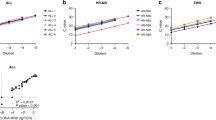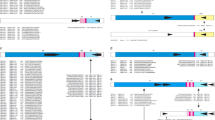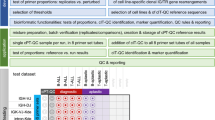Abstract
Quantification of residual leukemic cells at early time points during therapy can reliably predict the outcome in children with acute lymphoblastic leukemia (ALL). Recently, semiquantitative minimal residual disease (MRD) detection assays such as dot-blot hybridization have been replaced by real-time quantitative PCR. We tested the flexibility of the two most used real-time PCR machines: the SDS 7700 or ‘TaqMan’ (TM) (Applied Biosystems) and the LightCycler (LC) (Roche) instruments. Clonal T-cell receptor and immunglobulin gene rearrangements were used for MRD detection with germline hydrolyzation probes and clone-specific primers. Sensitivity tests for 65 clonal gene rearrangements and MRD quantification in 90 bone marrow samples during therapy of 49 children with ALL at diagnosis or relapse were performed with both machines. Both real-time PCR systems provided specific results for MRD quantification in all follow-up samples. In conclusion, we were able to demonstrate that TM and LC real-time PCR technologies produce similar MRD quantification results and that the quantification assays can be easily transferred from one detection system to the other. Using the same detection format, both techniques can be applied in combination in multicenter MRD studies.
This is a preview of subscription content, access via your institution
Access options
Subscribe to this journal
Receive 12 print issues and online access
$259.00 per year
only $21.58 per issue
Buy this article
- Purchase on Springer Link
- Instant access to full article PDF
Prices may be subject to local taxes which are calculated during checkout


Similar content being viewed by others
References
van-Dongen JJ, Seriu T, Panzer-Grumayer ER, Biondi A, Pongers-Willemse MJ, Corral L et al. Prognostic value of minimal residual disease in acute lymphoblastic leukaemia in childhood. Lancet 1998; 352: 1731–1738.
Coustan-Smith E, Sancho J, Hancock ML, Boyett JM, Behm FG, Raimondi SC et al. Clinical importance of minimal residual disease in childhood acute lymphoblastic leukemia. Blood 2000; 96: 2691–2696.
Cave H, van-der-Werff-ten-Bosch J, Suciu S, Guidal C, Waterkeyn C, Otten J et al. Clinical significance of minimal residual disease in childhood acute lymphoblastic leukemia. European Organization for Research and Treatment of Cancer – Childhood Leukemia Cooperative Group. N Engl J Med 1998; 339: 591–598.
Foroni L, Harrison CJ, Hoffbrand AV, Potter MN . Investigation of minimal residual disease in childhood and adult acute lymphoblastic leukaemia by molecular analysis. Br J Haematol 1999; 105: 7–24.
Pongers-Willemse MJ, Seriu T, Stolz F, d'Aniello E, Gameiro P, Pisa P et al. Primers and protocols for standardized detection of minimal residual disease in acute lymphoblastic leukemia using immunoglobulin and T cell receptor gene rearrangements and TAL1 deletions as PCR targets: report of the BIOMED-1 CONCERTED ACTION: investigation of minimal residual disease in acute leukemia. Leukemia 1999; 13: 110–118.
Szczepanski T, Flohr T, van der Velden VH, Bartram CR, van Dongen JJ . Molecular monitoring of residual disease using antigen receptor genes in childhood acute lymphoblastic leukaemia. Best Pract Res Clin Haematol 2002; 15: 37–57.
San Miguel JF, Parreira A, Wörmann B, Bartram C, Janossy G, Van Dongen JJ . Investigation of minimal residual disease in acute lymphoblastic leukemia: international standardisation and clinical evaluation. In: Baert AE, Baig SS, Bardoux C, Fracchia GN, Hallen M, Le Dour O, Razquin MC, Thévenin V, Vanvossel A and Vidal M (eds). European Union Biomedical and Health Research: The BIOMED-1 Programme. Amsterdam: IOS Press, 1995, 372–373.
van-Dongen JJ, Wolvers-Tettero IL . Analysis of immunoglobulin and T cell receptor genes. Part II: Possibilities and limitations in the diagnosis and management of lymphoproliferative diseases and related disorders. Clin Chim Acta 1991; 198: 93–174.
Sykes PJNS, Brisco MJ, Hughes E, Condon J, Morley AA . Quantitation of targets of PCR by use of limiting dilution. Biotechniques 1992; 13: 444–449.
Ouspenskaia MVJD, Roberts WM, Estrov Z, Zipf TF . Accurate quantitation of residual B-precursor acute lymphoblastic leukemia by limiting dilution and a PCR-based detection system: a description of the method and the principles involved. Leukemia 1995; 9: 321.
Cave H, Guidal C, Rohrlich P, Delfau M H, Broyart A, Lescoeur B et al. Prospective monitoring and quantitation of residual blasts in childhood acute lymphoblastic leukemia by polymerase chain reaction study of delta and gamma T-cell receptor genes. Blood 1994; 83: 1892–1902.
Pongers-Willemse MJ, Verhagen OJ, Tibbe GJ, Wijkhuijs AJ, de-Haas V, Roovers E et al. Real-time quantitative PCR for the detection of minimal residual disease in acute lymphoblastic leukemia using junctional region specific TaqMan probes. Leukemia 1998; 12: 2006–2014.
Verhagen OJ, Willemse MJ, Breunis WB, Wijkhuijs AJ, Jacobs DC, Joosten SA et al. Application of germline IGH probes in real-time quantitative PCR for the detection of minimal residual disease in acute lymphoblastic leukemia. Leukemia 2000; 14: 1426–1435.
van der Velden VH, Wijkhuijs JM, Jacobs DC, van Wering ER, van Dongen JJ . T cell receptor gamma gene rearrangements as targets for detection of minimal residual disease in acute lymphoblastic leukemia by real-time quantitative PCR analysis. Leukemia 2002; 16: 1372–1380.
van der Velden VHJ, Willemse MJ, van der Schoot CE, Hählen K, van Wering ER, van Dongen JJM . Immunoglobulin kappa deleting element rearrangements in precursor-B acute lymphoblastic leukemia are stable targets for detection of minimal residual disease by real-time quantitative PCR. Leukemia 2002; 16: 928–936.
Meijerink J, Mandigers C, van-de-Locht L, Tonnissen E, Goodsaid F, Raemaekers J . A novel method to compensate for different amplification efficiencies between patient DNA samples in quantitative real-time PCR. J Mol Diagn 2001; 3: 55–61.
Eckert C, Landt O, Taube T, Seeger K, Beyermann B, Proba J et al. Potential of LightCycler technology for quantification of minimal residual disease in childhood acute lymphoblastic leukemia. Leukemia 2000; 14: 316–323.
Nakao M, Janssen JW, Flohr T, Bartram CR . Rapid and reliable quantification of minimal residual disease in acute lymphoblastic leukemia using rearranged immunoglobulin and T-cell receptor loci by LightCycler technology. Cancer Res 2000; 60: 3281–3289.
Bennett JM, Catovsky D, Daniel MT, Flandrin G, Galton DA, Gralnick HR et al. Proposals for the classification of the acute leukaemias. French–American–British (FAB) co-operative group. Br J Haematol 1976; 33: 451–458.
van Dongen JJ, Adriaansen HJ, Hooijkaas H . Immunophenotyping of leukaemias and non-Hodgkin's lymphomas. Immunological markers and their CD codes. Neth J Med 1988; 33: 298–314.
Sambrook J, Fritsch EF, Maniatis T . Molecular Cloning: A laboratory Manual. Cold Spring Harbor: Cold Spring Harbor Laboratory Press, 1989.
Schrappe M, Reiter A, Zimmermann M, Harbott J, Ludwig W D, Henze G et al. Long-term results of four consecutive trials in childhood ALL performed by the ALL-BFM study group from 1981 to 1995. Berlin–Frankfurt–Munster. Leukemia 2000; 14: 2205–2222.
van Dongen JJ, Seriu T, Panzer-Grümayer ER, Biondi A, Pongers Willemse MJ, Corral L et al. Prognostic value of minimal residual disease in acute lymphoblastic leukaemia in childhood. Lancet 1998; 352: 1731–1738.
Henze G, Fengler R, Hartmann R . Chemotherapy for relapsed childhood acute lymphoblastic leukemia: results of the BFM Study Group. Haematol Blood Transfus 1994; 36: 374–379.
Henze G . Chemotherapy for relapsed childhood acute lymphoblastic leukemia. Int J Pediatr Hematol/Oncol 1998; 5: 199–213.
Eckert C, Biondi A, Seeger K, Cazzaniga G, Hartmann R, Beyermann B et al. Prognostic value of minimal residual disease in relapsed childhood acute lymphoblastic leukaemia. Lancet 2001; 358: 1239–1241.
Pongers Willemse MJ, Seriu T, Stolz F, d'Aniello E, Gameiro P, Pisa P et al. Primers and protocols for standardized detection of minimal residual disease in acute lymphoblastic leukemia using immunoglobulin and T cell receptor gene rearrangements and TAL1 deletions as PCR targets: report of the BIOMED-1 CONCERTED ACTION: investigation of minimal residual disease in acute leukemia. Leukemia 1999; 13: 110–118.
Taube T, Seeger K, Beyermann B, Hanel C, Duda S, Linderkamp C et al. Multiplex PCR for simultaneous detection of the most frequent T cell receptor-delta gene rearrangements in childhood ALL. Leukemia 1997; 11: 1978–1982.
Deane M, Norton JD . Immunoglobulin heavy chain variable region family usage is independent of tumor cell phenotype in human B lineage leukemias. Eur J Immunol 1990; 20: 2209–2217.
Szczepanski T, Willemse M, van Wering E, van Weerden J, Kamps W, van Dongen J . Precursor-B-ALL with D(H)–J(H) gene rearrangements have an immature immunogenotype with a high frequency of oligoclonality and hyperdiploidy of chromosome 14. Leukemia 2001; 15: 1415–1423.
Langerak AW, Szczepanski T, van der Burg M, Wolvers Tettero IL, van Dongen JJ . Heteroduplex PCR analysis of rearranged T cell receptor genes for clonality assessment in suspect T cell proliferations. Leukemia 1997; 11: 2192–2199.
Bottaro M, Berti E, Biondi A, Migone N, Crosti L . Heteroduplex analysis of T-cell receptor gamma gene rearrangements for diagnosis and monitoring of cutaneous T-cell lymphomas. Blood 1994; 83: 3271–3278.
Kreuzer KA, Lass U, Bohn A, Landt O, Schmidt CA . LightCycler technology for the quantitation of bcr/abl fusion transcripts. Cancer Res 1999; 59: 3171–3174.
Graf Einsiedel H, Taube T, Hartmann R, Wellmann S, Seifert G, Henze G et al. Deletion analysis of p16(INKa) and p15(INKb) in relapsed childhood acute lymphoblastic leukemia. Blood 2002; 99: 4629–4631.
Acknowledgements
This study was kindly supported by Deutsche Kinderkrebsstiftung, Germany, Fondazione Tettamanti, Associazione Italiana per la Ricerca sul Cancro (AIRC), MIUR cofin 40%, CNR Progetto Oncologia and Fondazione Cariplo.
Author information
Authors and Affiliations
Rights and permissions
About this article
Cite this article
Eckert, C., Scrideli, C., Taube, T. et al. Comparison between TaqMan and LightCycler technologies for quantification of minimal residual disease by using immunoglobulin and T-cell receptor genes consensus probes. Leukemia 17, 2517–2524 (2003). https://doi.org/10.1038/sj.leu.2403103
Received:
Accepted:
Published:
Issue Date:
DOI: https://doi.org/10.1038/sj.leu.2403103



